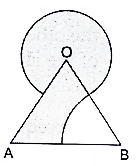Find the area of the shaded region in the given figure, where a circular arc of radius 6 cm has been drawn with vertex of an equilateral triangle of side 12 cm as centre and a sector of circle of radius 6 cm with centre B is made. [Use √3 = 1.73 and π = 3.14.]

Area of shaded region can be calculated by subtracting the area of minor sector at vertex B from the sum of areas of the major sector at O and area of equilateral triangle.
Given Radius of circle at O = r = 6 cm
Side of equilateral triangle = a = 12 cm
Central angle at O = 360 -60 = 300°
Central angle at B = 60°
Area of the equilateral triangle = ![]()
where a = side of equilateral triangle
Area of the equilateral triangle = ![]() (putting the value of a)
(putting the value of a)
Area of the equilateral triangle = (144×√3)/4
Area of the equilateral triangle = 36√3 cm2 → eqn1
Area of sector = θ/360×πR2 where r = radius of the sector
Area of minor sector at B = 60/360×π×(62) (given)
∴ Area of minor sector at B = 6π cm2→ eqn2
Similarly,
![]()
∴ Area of major sector at O = 30π cm2→ eqn3
Area of shaded region = eqn1 + eqn3 – eqn2
On putting values
⇒ Area of shaded region = 36√3 + 30π-6π
Area of shaded region = 36√3 + 24π
(put π = 3.14 and √3 = 1.73
∴ Area of shaded region = (36×1.73) + (24×3.14)
⇒ Area of shaded region = 62.28 + 75.36
∴ Area of shaded region = 137.64 cm2
Area of the shaded region is 137.64 cm2.